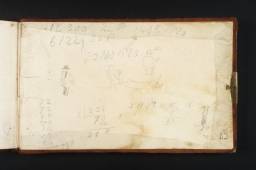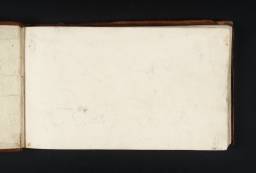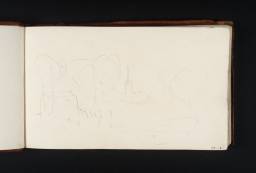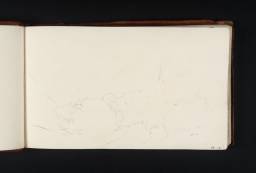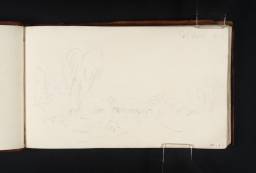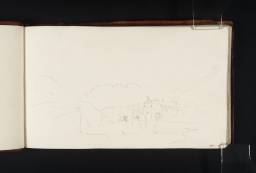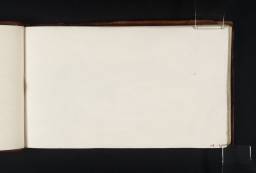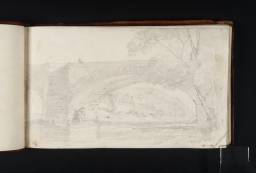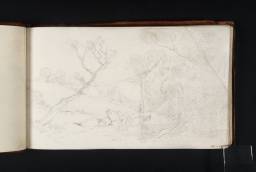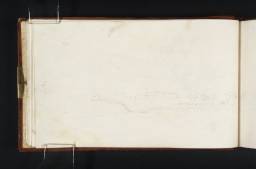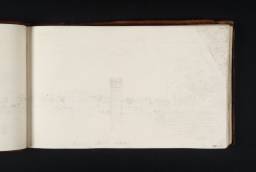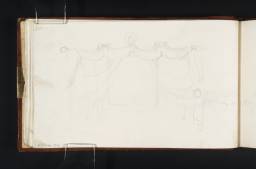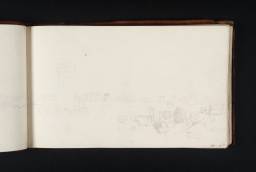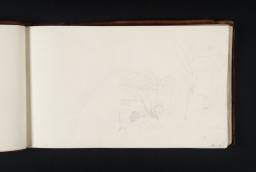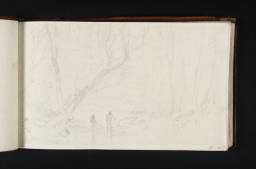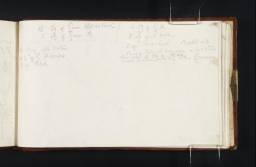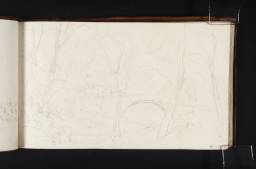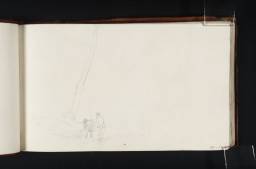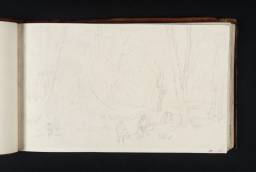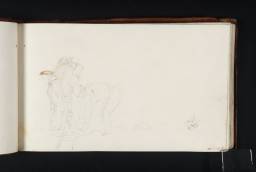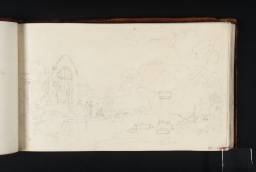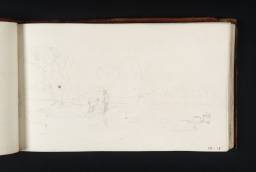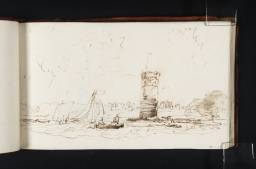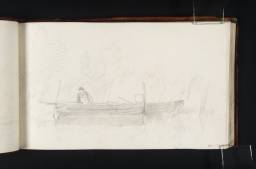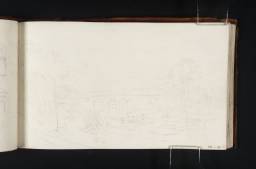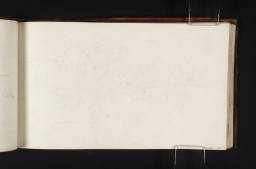Turner Bequest CV
Sketchbook, bound in calf, with one brass clasp (broken), spine repaired
92 leaves of white wove paper
Approximate page size 108 x 185 mm
Made by ?William Balston and the brothers Finch and Thomas Robert Hollingworth at Turkey Mill, Maidstone, Kent, and watermarked ‘J WHA[TMAN] | 180...’
Endorsed by the Executors of the Turner Bequest in ink ‘No.327. Contains 64 Leaves | Pencil Sketches’ and signed by Charles Turner in ink ‘C. Turner’ and by Charles Eastlake and John Prescott Knight in pencil ‘C.L.E.’ and ‘JPK’ on folio 93 verso (D07114)
Further endorsements by John Ruskin are recorded by Finberg: ‘327. English. Not very good’ and ‘Invent. 327. Interesting middle English Pastoral, London Bridge, &c. Essay on Reflections (optical) on first page’
92 leaves of white wove paper
Approximate page size 108 x 185 mm
Made by ?William Balston and the brothers Finch and Thomas Robert Hollingworth at Turkey Mill, Maidstone, Kent, and watermarked ‘J WHA[TMAN] | 180...’
Endorsed by the Executors of the Turner Bequest in ink ‘No.327. Contains 64 Leaves | Pencil Sketches’ and signed by Charles Turner in ink ‘C. Turner’ and by Charles Eastlake and John Prescott Knight in pencil ‘C.L.E.’ and ‘JPK’ on folio 93 verso (D07114)
Further endorsements by John Ruskin are recorded by Finberg: ‘327. English. Not very good’ and ‘Invent. 327. Interesting middle English Pastoral, London Bridge, &c. Essay on Reflections (optical) on first page’
Accepted by the nation as part of the Turner Bequest 1856
Exhibition history
References
This sketchbook was used during Turner’s visit to Sir John Leicester at Tabley, Cheshire, in 1808 and later in London. Some of its many views of the Thames and City are datable as late as 1825. Accounts or payments dated 14 October and 3 November 1820 are recorded inside the front cover (D40628).
Ruskin’s endorsements show that he revised his first, poor impression of the book, which contains much information although many of its pencil sketches are quite slight. The ‘middle English Pastoral’ subjects include drawings of the estate at Tabley, including two for Turner’s pictures Tabley, Cheshire, the Seat of Sir J.F. Leicester, Bart.: Calm Morning (Tate T03878; displayed at Petworth House)1 and Tabley, the Seat of Sir J.F. Leicester, Bart.: Windy Day (Tabley House Collection, University of Manchester).2 These drawings, respectively folios 8 verso–9 (D07129–D06990; Turner Bequest CV [91 verso]–7) and folio 20 (D07002; Turner Bequest CV 17), together with folios 70 verso–71 (D07075–D07118; Turner Bequest 62a–85a) show the water tower that Sir John had built in the lake. Turner omitted it from his first ideas for the pictures, including drawings and an oil sketch for the ‘Calm’ in the Tabley No.1 sketchbook (Tate D06845–D06846, D06848; Turner Bequest CIII 15a–16, 18), and was presumably told to include it.
Especially interesting in the present sketchbook are views around the Old Hall and of the family chapel, St Peter’s (for example folio 17, D07116; Turner Bequest CV 84), then standing on an island in the Moat. The Old Hall dated originally from circa 1382 but was mainly seventeenth-century. It was abandoned when Sir Peter Byrne Leicester, 4th Bart., built the present Tabley House (completed circa 1767) At the time of Turner’s visit it was well maintained with its original furnishings. St Peter’s Chapel, built 1675–8 and with a tower added in 1724, stood beside it. In the 1920s, both buildings were undermined by subsidence owing to brine extraction. The Chapel was dismantled and largely rebuilt near the Georgian house and the former mansion was left to collapse in 1927, although fixtures and fittings including a chimneypiece and heraldic and painted glass from the windows were salvaged for an Old Hall Room alongside the rebuilt church. Today the island and the surviving ruins are overgrown and inaccessible and Turner’s drawings may be compared with the view of the island, bridge and Old Hall and Chapel drawn by Sir John Leicester’s friend Richard Colt Hoare and engraved by James Storer for The Beauties of England and Wales, 1802.
On folio 35 (D07025; Turner Bequest CV 32) Turner outlines a hang of pictures at Tabley, including a ‘Landscape’ by Sir John Leicester himself and a view of Beeston Castle by George Barret which its owner presented to the Royal Irish Institution, Dublin, in 1823. Turner made his own watercolour of Beeston, near Tarporley, circa 1809 (Ulster Museum, Belfast),3 and probably saw it during his 1808 visit, although no on-the-spot drawings from this year are currently identified. Décor such as curtains and drapery, as on folio 9 verso (D06991; Turner Bequest CV 7a), may have been seen at Tabley, where improvements to the Georgian house designed by John Carr of York were under way, including a picture gallery newly formed by Thomas Harrison of Chester from smaller rooms. This room, of which a floor plan appears on folio 34 verso (D40629) together with the hang of three pictures mentioned above, was completed and installed by the time of Turner’s visit. James Hamilton says that having built a gallery in his London house in Hill Street, Sir John was ‘now actively contemplating a second’ and that ‘Turner’s experience as a picture gallery designer will have been invaluable to him, and it is inconceivable that they did not discuss the subject’.4 In fact, most of the ideas for a picture gallery in this sketchbook are for Turner’s own London gallery and later in date. Although Turner made some alterations to his first Harley Street gallery during 1811, these drawings are for the new gallery at the back of his house in Queen Anne Street West, planned from about 1818 and opened in 1822. Probably he made them while referring back to his notes and sketches made at Tabley. Plans include heating, top-lighting and hangings to frame pictures or shield them from glare. While the octagonal glazed roof lights and sloped ceiling drawn on folio 48 (D07046; Turner Bequest CV 44) conform to Turner’s Gallery as later painted by George Jones (Ashmolean Museum, Oxford), and Jones also shows simple fabric hangings on the walls, some of the designs for drapery sketched here seem rather grand and elegant for the frugal Turner, who in later years used herring nets to filter daylight from the roof.
Ruskin’s mention of subjects of ‘London Bridge &c’ would seem to contradict Eric Shanes’s former theory that a number of views of the Pool of London and the Custom House have been ‘bound in the book by error’.5 Moreover, one of these, on folio 70 (D07074; Turner Bequest CV 62) is on the other side of half of a double-page spread view of Tabley (D07075; Turner Bequest CV 62a). Rather than insertions from another source, the Thames subjects must have been drawn in the book as part of a separate, later campaign. As Shanes observes, some show the new central façade added by Robert Smirke in 1825 to the Custom House as rebuilt by David Laing, 1813–17; see especially folio 75 verso (D07083; Turner Bequest CV 66a). Turner’s drawings are preparatory to the watercolour The Custom House (Vancouver Art Gallery)6 engraved by J.C. Allen in 1827. Folio 76 (D07115; Turner Bequest CV 83) is related to another watercolour Old London Bridge dated 1824 (Victoria and Albert Museum, London)7 engraved by Edward Goodall while folios 64 verso–66 (D07063–D07066; Turner Bequest CV 56a–58) must be connected with a third, The Tower of London (private collection)8 engraved by William Miller in 1831. A group of drawings of Waterloo Bridge and Somerset House at the back of the book (for example folios 87 verso–88, D07105–D07106; Turner Bequest CV 77a–78) suggest that Turner was also planning a view of these important subjects. Somerset House was of personal significance as the home of the Royal Academy while the bridge designed by John Rennie, 1811–16 (renamed from Strand Bridge and formally opened in 1817) was still quite new.
The likelihood that these watercolours were intended for an engraved series of London scenes, first mooted by the publisher W.B. Cooke in 1820 and taken over by Allen by the time it was announced in The Repository of Arts in August 1824,9 is discussed in detail by Shanes.10 By 1824, it was titled ‘Views in London and its environs’, to be issued quarterly in numbers of two prints, together ‘comprising the most interesting Scenes in and about the Metropolis’ and ‘all that time or intrinsic worth has consecrated in London’. Besides Turner, other artists were to contribute including his friend Augustus Callcott whose large painting The Entrance to the Pool of London (Bowood House) had made a great impression on Turner in the Royal Academy in 1816.11 As Shanes explains, the project was not realised as it was overtaken by a rival ‘Picturesque Views in London and its environs’, published by Hurst and Robinson with engravings by Charles Heath after different artists. The prints after Turner’s Thames scenes were issued separately or in other publications. Their relationship to the Cooke/Allen scheme is speculative but seems likely on grounds of date and the richness and variety of the subject matter.
The written notes in this book range from the historical and antiquarian, based on old sources from Suetonius and Cassius Dio to Giraldus Cambrensis, to personal observations. Passages about the Roman occupation of Britain and the early history of its architecture (folios 90 verso and 91 verso, D07110, D07112; Turner Bequest CV 80a, 81a) may have been prompted by contact with Richard Colt Hoare, who had published an edition of Giraldus’s Itinerarium or Journey through Wales in 1806; Turner is likely to have overlapped with Hoare or stayed at his summer villa near Bala on an excursion into North Wales from Tabley during his 1809 tour.12 Other text is written in connection with Turner’s preparations for his forthcoming lectures as Professor of Perspective at the Royal Academy. On folio 92 verso and inside the back cover (D07114, D40630) he describes the tantalising effects of ‘currants, air and motion’ on reflections seen in water and the difficulty of finding technical means or ‘rules’ for depicting them, concluding wistfully that ‘panting art toils after truth in vain’. These notes might be read in conjunction with his remarks on the appearance of a ‘white Body’ floating down the Rive Dee, observed on the trip to Wales (Tabley No.2 sketchbook, Tate D06983; Turner Bequest CIV 88).
Ackermann’s The Repository of Arts, Literature, Fashions, Manufactures, etc., 1 August 1824, vol.IV, no.20, p.121.
See also James Hamilton, Turner’s Britain, exhibition catalogue, Birmingham Museums and Art Gallery, 2003, pp.126–30.
David Blayney Brown, Augustus Wall Callcott, exhibition catalogue, Tate Gallery, London 1981, pp.78–9.
See Introduction to Tabley No.1 sketchbook (Tate D06830–D06857; D40065; D40720–D40721; Turner Bequest CIII).
Technical notes
A concordance follows:
| Folio | Tate | Turner Bequest |
| Inside Front Cover | D40628 | |
| 1 | D06984 | CV 1 |
| 2 | D06985 | CV 2 |
| 3 | D06986 | CV 3 |
| 4 | D06987 | CV 4 |
| 5 | D06988 | CV 5 |
| 6 | D06989 | CV 6 |
| 7 | D07126 | CV 90 |
| 8 | D07128 | CV 91 |
| 8 verso | D07129 | |
| 9 | D06990 | CV 7 |
| 9 verso | D06991 | CV 7a |
| 10 | D06992 | CV 8 |
| 11 | D06993 | CV 9 |
| 12 | D06994 | CV 10 |
| 12 verso | D06995 | CV 10a |
| 13 | D06996 | CV 11 |
| 14 | D06997 | CV 12 |
| 15 | D06999 | CV 14 |
| 16 | D06998 | CV 13 |
| 17 | D07116 | CV 84 |
| 18 | D07000 | CV 15 |
| 19 | D07001 | CV 16 |
| 20 | D07002 | CV 17 |
| 21 | D07003 | CV 18 |
| 22 | D07004 | CV 19 |
| 22 verso | D07005 | CV 19a |
| 23 | D07006 | CV 20 |
| 23 verso | D07007 | CV 20a |
| 24 | D07008 | CV 21 |
| 24 verso | D07009 | CV 21a |
| 25 | D07010 | CV 22 |
| 25 verso | D07011 | CV 22a |
| 26 | D07012 | CV 23 |
| 27 | D07013 | CV 24 |
| 28 | D07014 | CV 25 |
| 29 | D07015 | CV 26 |
| 30 | D07016 | CV 27 |
| 30 verso | D07017 | CV 27a |
| 31 | D07018 | CV 28 |
| 31 verso | D07019 | CV 28a |
| 32 | D07020 | CV 29 |
| 32 verso | D07021 | CV 29a |
| 33 | D07022 | CV 30 |
| 33 verso | D07023 | CV 30a |
| 34 | D07024 | CV 31 |
| 34 verso | D40629 | |
| 35 | D07025 | CV 32 |
| 36 | D07026 | CV 33 |
| 37 | D07027 | CV 34 |
| 38 | D07028 | CV 35 |
| 38 verso | D07029 | CV 35a |
| 39 | D07030 | CV 36 |
| 39 verso | D07031 | CV 36a |
| 40 | D07032 | CV 37 |
| 40 verso | D07033 | CV 37a |
| 41 | D07121 | CV 87a |
| 41 verso | D07120 | CV 87 |
| 42 | D07034 | CV 38 |
| 42 verso | D07035 | CV 38a |
| 43 | D07036 | CV 39 |
| 43 verso | D07037 | CV 39a |
| 44 | D07038 | CV 40 |
| 44 verso | D07039 | CV 40a |
| 45 | D07040 | CV 41 |
| 45 verso | D07041 | CV 41a |
| 46 | D07042 | CV 42 |
| 46 verso | D07043 | CV 42a |
| 47 | D07044 | CV 43 |
| 47 verso | D07045 | CV 43a |
| 48 | D07046 | CV 44 |
| 48 verso | D07047 | CV 44a |
| 49 | D07048 | CV 45 |
| 49 verso | D07049 | CV 45a |
| 50 | D07050 | CV 46 |
| 51 | D07051 | CV 47 |
| 52 | D07052 | CV 48 |
| 53 | D07053 | CV 49 |
| 54 | D07054 | CV 50 |
| 55 | D07055 | CV 51 |
| 56 | D07056 | CV 52 |
| 57 | D07057 | CV 53 |
| 58 | D07058 | CV 54 |
| 58 verso | D07059 | CV 54a |
| 59 | D07119 | CV 86 |
| 59 verso | D40638 | |
| 60 | D07130 | CV 92 |
| 60 verso | D07131 | CV 92a |
| 61 | D07125 | CV 89a |
| 61 verso | D07124 | CV 89 |
| 62 | D07060 | CV 55 |
| 62 verso | D07061 | CV 55a |
| 63 | D07122 | CV 88 |
| 63 verso | D07123 | CV 88a |
| 64 | D07062 | CV 56 |
| 64 verso | D07063 | CV 56a |
| 65 | D07064 | CV 57 |
| 65 verso | D07065 | CV 57a |
| 66 | D07066 | CV 58 |
| 66 verso | D07067 | CV 58a |
| 67 | D07068 | CV 59 |
| 67 verso | D07069 | CV 59a |
| 68 | D07070 | CV 60 |
| 68 verso | D07071 | CV 60a |
| 69 | D07072 | CV 61 |
| 69 verso | D07073 | CV 61a |
| 70 | D07074 | CV 62 |
| 70 verso | D07075 | CV 62a |
| 71 | D07118 | CV 85a |
| 71 verso | D07117 | CV 85 |
| 72 | D07076 | CV 63 |
| 72 verso | D07077 | CV 63a |
| 73 | D07078 | CV 64 |
| 73 verso | D07079 | CV 64a |
| 74 | D07080 | CV 65 |
| 74 verso | D07081 | CV 65a |
| 75 | D07082 | CV 66 |
| 75 verso | D07083 | CV 66a |
| 76 | D07115 | CV 83 |
| 77 | D07084 | CV 67 |
| 77 verso | D07085 | CV 67a |
| 78 | D07086 | CV 68 |
| 78 verso | D07087 | CV 68a |
| 79 | D07088 | CV 69 |
| 79 verso | D07089 | CV 69a |
| 80 | D07090 | CV 70 |
| 80 verso | D07091 | CV 70a |
| 81 | D07092 | CV 71 |
| 81 verso | D07093 | CV 71a |
| 82 | D07094 | CV 72 |
| 82 verso | D07095 | CV 72a |
| 83 | D07096 | CV 73 |
| 83 verso | D07097 | CV 73a |
| 84 | D07098 | CV 74 |
| 84 verso | D07099 | CV 74a |
| 85 | D07100 | CV 75 |
| 85 verso | D07101 | CV 75a |
| 86 | D07102 | CV 76 |
| 86 verso | D07103 | CV 76a |
| 87 | D07104 | CV 77 |
| 87 verso | D07105 | CV 77a |
| 88 | D07106 | CV 78 |
| 88 verso | D07107 | CV 78a |
| 89 | D07108 | CV 79 |
| 90 | D07109 | CV 80 |
| 90 verso | D07110 | CV 80a |
| 91 | D07111 | CV 81 |
| 91 verso | D07112 | CV 81a |
| 92 | D07113 | CV 82 |
| 92 verso | D07114 | |
| Inside Back Cover | D40630 |
How to cite
David Blayney Brown, ‘Tabley No.3 sketchbook 1808–25’, sketchbook, February 2011, in David Blayney Brown (ed.), J.M.W. Turner: Sketchbooks, Drawings and Watercolours, Tate Research Publication, December 2012, https://www

